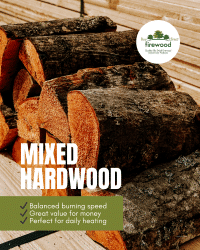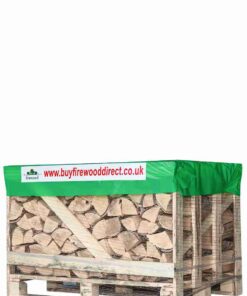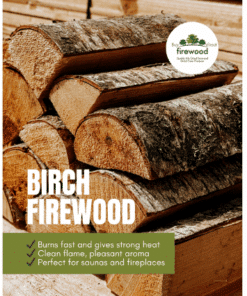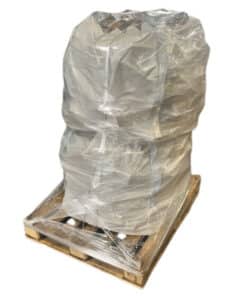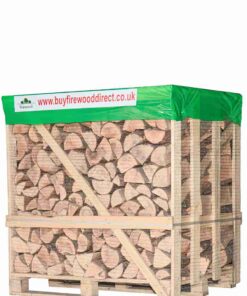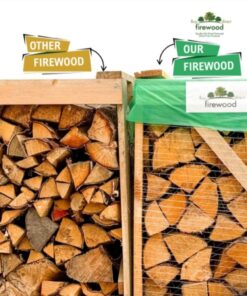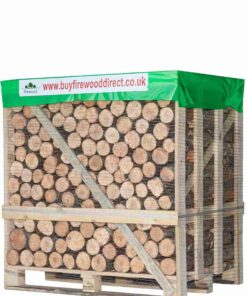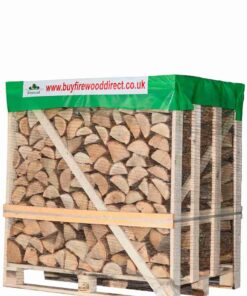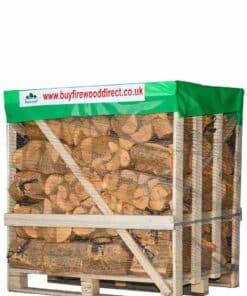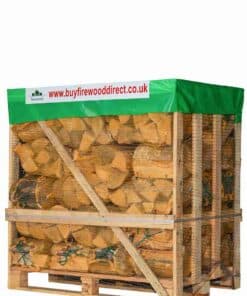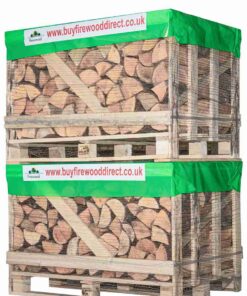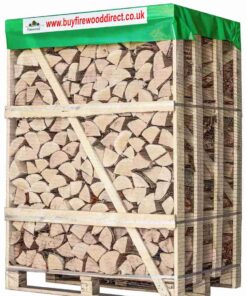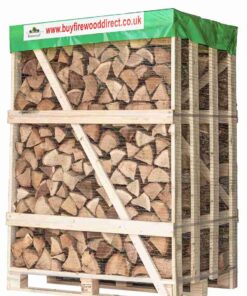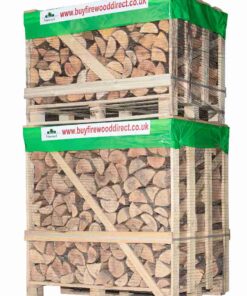When it comes to heating your home, the quality of your firewood makes all the difference. You want a fuel that burns cleanly, produces excellent heat, and is efficient. Two common terms you’ll encounter are “kiln-dried” and “seasoned.” While both refer to logs with reduced moisture, they are far from the same. Understanding the distinction is key to getting the most out of your wood-burning stove or fireplace.
This guide will explore the differences between kiln-dried and seasoned logs. We will cover what kiln-dried logs are, the challenges of traditional seasoning, the benefits of using kiln-dried hardwoods, and the precise process that makes them a superior fuel source.
What Are Kiln-Dried Logs?
Kiln-dried logs are logs that have been dried in a purpose-built industrial oven, or kiln. This is a controlled and highly efficient process designed to reduce the internal moisture content of the wood to a specific, low level—typically below 20%. By using regulated heat and airflow, the kiln forces moisture out of the wood in a matter of days, rather than the months or even years required for traditional seasoning.
The result is a log that is uniformly dry, from the outer bark to the very core. This consistency is something that air-drying, or seasoning, can rarely achieve. Because the process is standardized, you can be confident that every log in a batch of kiln-dried firewood meets a quality benchmark. This guarantees a clean, hot, and efficient burn every time you light your fire. This process is why kiln-dried logs are often certified as “Ready to Burn,” a scheme that assures you’re getting fuel suitable for immediate use.
The Challenges of Properly Seasoning Logs
Seasoning is the traditional method of drying wood. It involves stacking freshly cut logs in a sheltered, well-ventilated area and leaving them exposed to the elements to air-dry naturally. While this method can eventually reduce moisture content, it is fraught with challenges and inconsistencies that often result in subpar firewood.
1. The Time Factor
Properly seasoning hardwood logs can take a significant amount of time. Depending on the wood species, log size, and climate, it can take anywhere from six months to over two years for the moisture content to drop to an acceptable level. For dense hardwoods like oak, the process can be even longer. This extended timeline requires patience and a large, dedicated storage space that many people simply don’t have.
2. Environmental Dependency
The success of seasoning is heavily dependent on environmental conditions. The process relies on a good balance of sun, wind, and low humidity. In regions with long, damp winters or high humidity, air-drying is slow and often ineffective. If the wood is exposed to too much rain, it can reabsorb moisture, prolonging the drying time or even leading to rot and mold. Inconsistent weather means the final moisture content of seasoned logs can vary dramatically from one log to another.
3. Inconsistent Drying
One of the biggest issues with seasoned logs is the lack of uniform drying. While the outside of a log may feel dry to the touch, the core can still retain a high level of moisture. This is because air-drying is a passive process that dries the wood from the outside in. Without the forced heat of a kiln to penetrate the core, it’s common for seasoned logs to have a moisture content well above the ideal 20%. Trying to burn these logs leads to a frustrating experience filled with smoke, soot, and very little heat.
4. Risk of Mold and Pests
When wood sits for extended periods in outdoor conditions, it becomes an inviting home for insects, fungi, and mold. Damp wood is particularly susceptible to decomposition. Not only does this degrade the quality of the firewood, but it also means you could be bringing pests and mold spores into your home when you stack your logs by the fireplace.
5. Why Seasoned Logs Often Fail to Meet Standards
Due to these challenges, many logs sold as “seasoned” do not meet the “Ready to Burn” standard of sub-20% moisture content. A seller might claim the wood has been seasoned for a year, but if the storage conditions were poor, the logs could still be far too wet to burn efficiently. Without specialized equipment to test the internal moisture, it’s nearly impossible for a buyer to verify the quality before purchase. This gamble often leads to wasted money and poor performance from your heating appliance.
The Superior Benefits of Kiln-Dried Hardwoods
Choosing kiln-dried hardwoods over their seasoned counterparts provides a range of significant advantages. These benefits translate to better performance, greater efficiency, and a more enjoyable experience.
1. Higher Heat Output
The primary goal of burning firewood is to generate heat. The moisture content of a log has a direct impact on its ability to produce energy. When you burn a log with high moisture content, a significant amount of the energy created by combustion is wasted on boiling off the water trapped inside the wood. This energy is lost as steam up the chimney instead of radiating as heat into your room.
Because kiln-dried logs have a moisture content below 20%, very little energy is wasted. Almost all of the wood’s stored energy is converted directly into heat, resulting in a hotter fire. You’ll feel the difference in the warmth of your home and may even find you need to use fewer logs to maintain a comfortable temperature.
2. Cleaner Burn and Less Smoke
Incomplete combustion, caused by burning wet wood, produces excessive smoke and harmful particulates. This smoke contains creosote, a tar-like substance that can build up on the inside of your chimney or flue. A heavy accumulation of creosote is a serious fire hazard and requires frequent, costly professional cleaning.
Kiln-dried logs ignite quickly and burn hot, leading to more complete combustion. This results in significantly less smoke and fewer harmful emissions. For a visual demonstration of how cleanly kiln-dried logs burn, you can watch videos like the ones from Buy Firewood Direct’s YouTube channel, which show the minimal smoke produced. A cleaner burn is better for your appliance, your chimney, and the environment.
3. Increased Efficiency and Value for Money
While the upfront cost of kiln-dried logs can be higher than seasoned wood, they offer better value for money in the long run. Since they produce more heat per log, you will use less fuel to achieve the same level of warmth. This means a crate of kiln-dried logs will last longer than a similarly sized pile of poorly seasoned wood.
Furthermore, the clean burn protects your wood-burning stove and flue system from damage and reduces the need for frequent maintenance. When you factor in the fuel savings and reduced cleaning costs, kiln-dried logs prove to be a more economical choice over time.
4. Convenience and Immediate Use
Kiln-dried logs are ready to burn the moment they are delivered. There is no waiting, no guessing about moisture content, and no need to season them further. Products like the crates offered by Buy Firewood Direct are delivered neatly stacked and ready for immediate use, providing ultimate convenience. This is perfect for those who want a hassle-free, reliable fuel source without the labor and uncertainty of seasoning their own wood.
5. Pest-Free and Clean
The high temperatures used in the kiln drying process sterilize the wood, killing any insects, larvae, and mold spores. This ensures that you are bringing a clean, pest-free product into your home. You can store your logs indoors without worrying about unwanted critters or allergens.
The Kiln Drying Process: A Step-by-Step Guide
The journey from a freshly felled tree to a perfectly dried log is a precise and scientific process. Understanding how kiln-dried logs are made highlights why they are a premium product.
Step 1: Sourcing and Cutting
The process begins with responsibly sourced timber. High-quality firewood producers use hardwoods like birch, ash, and oak, which are known for their high density and excellent burning properties. Once the trees are harvested, they are transported to a processing yard where they are cut into uniform log lengths, typically around 25cm (10 inches), to fit most standard wood-burning stoves and fireplaces. The logs are also split to expose more surface area, which aids in the drying process.
Step 2: Loading the Kiln
The split logs are then carefully stacked into large metal cages or crates. This stacking method is crucial, as it ensures that hot air can circulate freely around every log. Proper airflow is essential for achieving uniform drying throughout the entire batch. Once filled, these crates are loaded into the kiln, a large, insulated chamber designed to withstand high temperatures.
Step 3: The Drying Cycle
This is the heart of the operation. The kiln’s temperature and humidity levels are carefully controlled by a computerized system. The cycle begins by gradually heating the kiln to temperatures that can exceed 70°C (160°F). Large fans circulate the hot, dry air through the stacks of wood, forcing the moisture from the core of the logs to the surface, where it evaporates.
The humid air is then vented out of the kiln, and fresh, drier air is introduced. This cycle of heating and venting continues for several days. The duration depends on the species of wood, its initial moisture content, and the size of the logs. The controlled environment accelerates the drying process exponentially compared to outdoor seasoning.
Step 4: Quality Control and Moisture Testing
Throughout the drying cycle, the moisture content of the wood is regularly monitored. Samples are taken from the core of the logs and tested with a moisture meter to ensure they are drying evenly. The process is complete only when the internal moisture content is consistently below the 20% threshold. This meticulous quality control is what guarantees that every log is “Ready to Burn.”
Step 5: Cooling and Packaging
Once the logs have reached the target moisture level, the kiln is switched off, and the wood is allowed to cool down. After cooling, the logs are packaged for delivery. Many suppliers, like Buy Firewood Direct, pack the logs into convenient crates or nets. Crates are an excellent option as they keep the logs neatly stacked and allow for continued airflow, ensuring they remain dry during storage.
For an inside look at the scale and efficiency of this operation, you can explore the resources on the Buy Firewood Direct website, which details their commitment to quality from forest to fireplace.
Conclusion: The Clear Choice for Modern Heating
While traditional wood seasoning has been used for centuries, it is an unpredictable process that often yields inconsistent results. The challenges of time, weather, and space make it difficult to achieve the low moisture content needed for an efficient and clean burn.
Kiln-dried logs offer a modern, reliable, and superior alternative. Through a controlled, scientific process, they are guaranteed to have a low moisture content, providing numerous benefits:
- Higher Heat Output: More warmth for your home with less wood.
- Cleaner Burning: Less smoke, creosote, and harmful emissions.
- Greater Efficiency: Better value for money through reduced fuel consumption.
- Guaranteed Quality: Pest-free, mold-free, and ready to burn immediately.
By choosing kiln-dried hardwoods, you are investing in a premium fuel that enhances the performance of your wood-burning stove, simplifies your life, and provides a cozy, reliable source of heat. Explore the range of kiln-dried products, from birch to oak, available from trusted suppliers to experience the difference for yourself.




